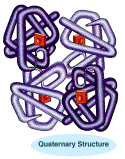 |
OVERVIEW
-
A characteristic SHAPE
ultimately results from the hierarchical structure of proteins: primary
structure ---> secondary structure ---> tertiary structure ---> quaternary
structure
-
This shape is critical because
most proteins function by binding to molecules (a substrate
or
a ligand) or to another protein ....... this
requires complementary fit ..............
the shape of the protein (which is determined by its structure)
must be correct in order to match the shape of the substrate or ligand!
-
For example: the shape
of the active site of an enzyme
must be complementary to the shape of the substrate
molecule. This enables, the substrate to fit into the active site;
as a result the enzyme catalyzes a biochemical reaction.
-
If the biochemical reaction is catalyzed,
then metabolism is normal and the phenotype is normal.

|